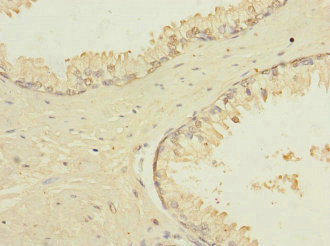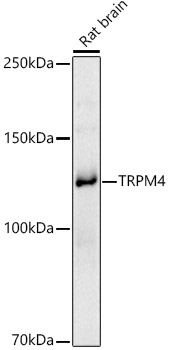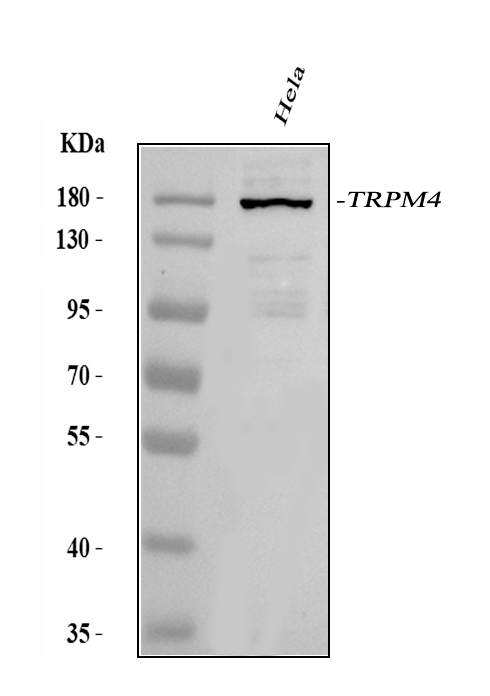![IHC-P analysis of liver carcinoma tissue using GTX83491 TRPM4 antibody [14C3]. Antigen retrieval : Heat-induced epitope retrieval by 10mM citrate buffer, pH6.0, 100oC for 10min. Dilution : 1:50 IHC-P analysis of liver carcinoma tissue using GTX83491 TRPM4 antibody [14C3]. Antigen retrieval : Heat-induced epitope retrieval by 10mM citrate buffer, pH6.0, 100oC for 10min. Dilution : 1:50](https://www.genetex.com/upload/website/prouct_img/normal/GTX83491/GTX83491_1449_IHC-P_w_23061419_137.webp)
IHC-P analysis of liver carcinoma tissue using GTX83491 TRPM4 antibody [14C3]. Antigen retrieval : Heat-induced epitope retrieval by 10mM citrate buffer, pH6.0, 100oC for 10min. Dilution : 1:50
TRPM4 antibody [14C3]
GTX83491
ApplicationsWestern Blot, ImmunoHistoChemistry, ImmunoHistoChemistry Paraffin
Product group Antibodies
TargetTRPM4
Overview
- SupplierGeneTex
- Product NameTRPM4 antibody [14C3] - Overexpression Validated
- Delivery Days Customer9
- Application Supplier NoteWB: 1:2000. IHC-P: 1:50. *Optimal dilutions/concentrations should be determined by the researcher.Not tested in other applications.
- ApplicationsWestern Blot, ImmunoHistoChemistry, ImmunoHistoChemistry Paraffin
- CertificationResearch Use Only
- ClonalityMonoclonal
- Clone ID14C3
- Concentration0.7 mg/ml
- ConjugateUnconjugated
- Gene ID54795
- Target nameTRPM4
- Target descriptiontransient receptor potential cation channel subfamily M member 4
- Target synonymsEKVP6, LTrpC4, PFHB1B, TRPM4B, hTRPM4, transient receptor potential cation channel subfamily M member 4, calcium-activated non-selective cation channel 1, long transient receptor potential channel 4, melastatin-4
- HostMouse
- IsotypeIgG1
- Protein IDQ8TD43
- Protein NameTransient receptor potential cation channel subfamily M member 4
- Scientific DescriptionCalcium-activated non selective (CAN) cation channel that mediates membrane depolarization. While it is activated by increase in intracellular Ca(2+), it is impermeable to it. Mediates transport of monovalent cations (Na(+) > K(+) > Cs(+) > Li(+)), leading to depolarize the membrane. It thereby plays a central role in cadiomyocytes, neurons from entorhinal cortex, dorsal root and vomeronasal neurons, endocrine pancreas cells, kidney epithelial cells, cochlea hair cells etc. Participates in T-cell activation by modulating Ca(2+) oscillations after T lymphocyte activation, which is required for NFAT-dependent IL2 production. Involved in myogenic constriction of cerebral arteries. Controls insulin secretion in pancreatic beta-cells. May also be involved in pacemaking or could cause irregular electrical activity under conditions of Ca(2+) overload.
- Storage Instruction-20°C or -80°C,2°C to 8°C
- UNSPSC12352203

![IHC-P analysis of liver tissue using GTX83491 TRPM4 antibody [14C3]. Antigen retrieval : Heat-induced epitope retrieval by 10mM citrate buffer, pH6.0, 100oC for 10min. Dilution : 1:50 IHC-P analysis of liver tissue using GTX83491 TRPM4 antibody [14C3]. Antigen retrieval : Heat-induced epitope retrieval by 10mM citrate buffer, pH6.0, 100oC for 10min. Dilution : 1:50](https://www.genetex.com/upload/website/prouct_img/normal/GTX83491/GTX83491_1450_IHC-P_w_23061419_469.webp)
![WB analysis of PC12 cell lysate using GTX83491 TRPM4 antibody [14C3]. Loading : 10 ug per lane Dilution : 1:200 WB analysis of PC12 cell lysate using GTX83491 TRPM4 antibody [14C3]. Loading : 10 ug per lane Dilution : 1:200](https://www.genetex.com/upload/website/prouct_img/normal/GTX83491/GTX83491_3421_WB_w_23061419_450.webp)
![WB analysis of HEK293T cells transfected with TRPM4 plasmid (Right) or empty vector (Left) for 48 hrs using GTX83491 TRPM4 antibody [14C3]. Loading : 5 ug per lane WB analysis of HEK293T cells transfected with TRPM4 plasmid (Right) or empty vector (Left) for 48 hrs using GTX83491 TRPM4 antibody [14C3]. Loading : 5 ug per lane](https://www.genetex.com/upload/website/prouct_img/normal/GTX83491/GTX83491_3668_WB_w_23061419_853.webp)

![IHC-P analysis of human liver carcinoma tissue using GTX83489 TRPM4 antibody [10H5]. Antigen retrieval : Heat-induced epitope retrieval by 10mM citrate buffer, pH6.0, 100oC for 10min.](https://www.genetex.com/upload/website/prouct_img/normal/GTX83489/GTX83489_1444_IHC-P_w_23061419_468.webp)
![WB analysis of various cell lines using GTX83490 TRPM4 antibody [3C4]. Loading : 35 ug per lane Dilution : 1:200](https://www.genetex.com/upload/website/prouct_img/normal/GTX83490/GTX83490_3420_WB_w_23061419_110.webp)





